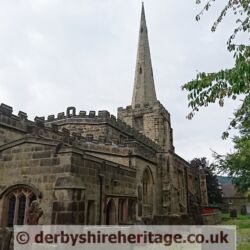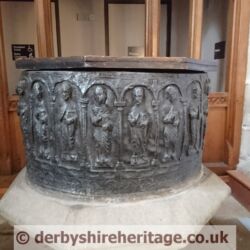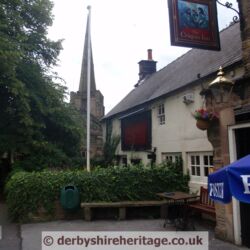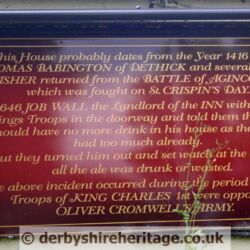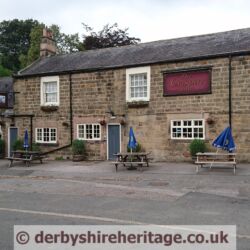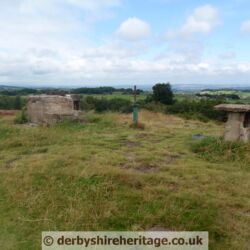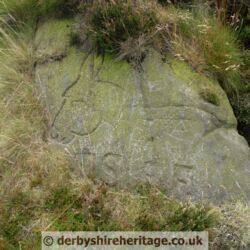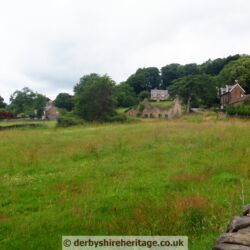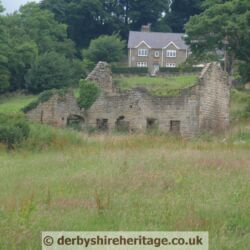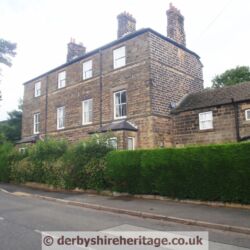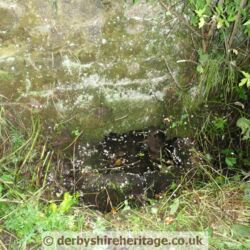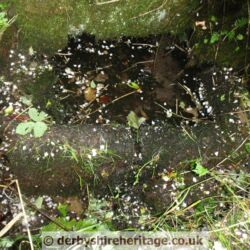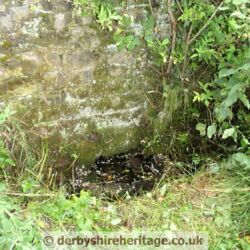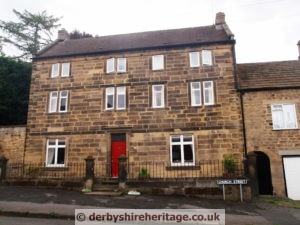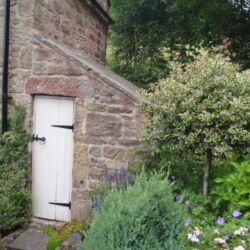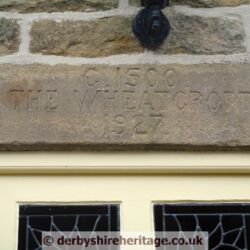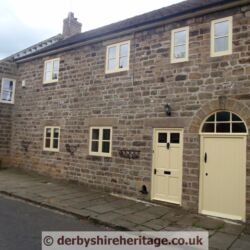Ashover was situated at the end of the Old Ash Forest and was known in Saxon times as “Essovre”, meaning “beyond the Ash Trees”.
The village was probably in existence when the first ever taxation survey of England was made by King Alfred in 893 but the first written reference to Ashover occurs in the Domesday Book of 1086, in which Ashover was credited with a church, a priest, a plough, and a mill, with a total taxable value of £4.00.
 Ashover was a very busy place in the past with lead mines, 13 lime kilns, quarries, coal at nearby Alton, lead smelting at Stonedge, lace thread at Kelstedge, four flour mills on the Amber, shoemakers, nailmakers, basketmakers, stocking frames, cutlery business and rope works.
Ashover was a very busy place in the past with lead mines, 13 lime kilns, quarries, coal at nearby Alton, lead smelting at Stonedge, lace thread at Kelstedge, four flour mills on the Amber, shoemakers, nailmakers, basketmakers, stocking frames, cutlery business and rope works.
Lavender, roses, valerian, camomile, and other plants were grown in large quantities, dried, and used for medical and other purposes.
Electricity came to the valley in the 1920’s but it was not until the late 1930’s that Ashover was connected to the National Grid and many outlying farms and hamlets were not supplied until after the Second World War. Gas street lamps were replaced by electric lighting as late as 1967.
During the Civil War Ashover suffered from both the King’s men and the Parliamentarians. The Roundheads destroyed the church windows to get at the lead which they used to cast lead shot and destroyed Eastwood Hall. Fortunately the vicar realised the Roundheads were coming and buried the lead font. This is now the only lead font to survive in Derbyshire.
All Saints Church
Built between 1350 and 1419 by Thomas Babington, the great-grandfather of the Anthony Babington, executed at Smithfield for the plot, on behalf of Mary, Queen of Scots, to murder Elizabeth I. The north aisle is earlier, mid-14th Century, and the south porch dates from 1275.
Just inside the main door is a plaque, listing the Rectors of Ashover from 1086. There were only 8 Rectors between 1621 and 1942 and the Nodder family can trace their descent back through the Bournes to the Reresbys, who were squarsons, (that is both local squire and parson), of Ashover in the 13th Century.
The font is one of the few Norman lead fonts in England and dates from about 1150. The top of the octagonal spire is 128 feet, (about 39 metres), from the ground.
Detailed information can be found at the All Saints Church website.
The Royalists slaughtered livestock and drank all the wine and ale in the cellars of Eddleston Hall while the owner Sir John Pershall was away. Job Wall, the landlord of the Crispin Inn, refused them entry, telling them they had already had too much to drink. But they threw him out and drank the ale, pouring what was left down the street. The CRISPIN INN was named after St Crispin the patron saint of cobblers, tanners and leather workers (St Crispins day falls on the 25th October) and the inn was once occupied by a cobbler.
A Royal Observer Corps post was opened in January 1938 at 299 metres above sea level at a place known locally as ‘Ashover Rock’ a rocky out crop on the ‘The Fabrick’.
Apart from the usual carved initials there are two nearby rocks with a donkey and ducks carved on them.
The ROPE FIELD on Malthouse Lane was used to spin ropes for the mines. Some of these reached right across the Moor Road down to the Church gate and claimed to be the longest ropes made in the country. They were used in the mines.
ASHOVER HOUSE HYDRO
Until 1963, there was a hydro in the village, sourcing its own private water supply from a tank on a hillside.
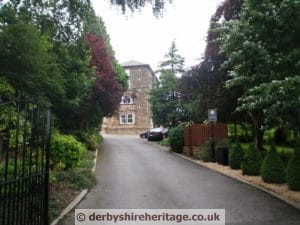
Ashover had two hydropathic institutions, the Ashover House Hydro and Ambervale, which were popular in the 19th century due to the belief in ‘healing water’.
Ashover House Hydro was built in 1869 and subsequently purchased by the electricity board in 1963 but today is divided into private apartments. Ambervale was built about ten years later.
According to the ‘Ashover Village Trail’ – One notable visitor to the Hydro was an aged millionaire who, although born in Alfreton, had emigrated to America. In spite of this it was his custom to make an annual ‘pilgrimage’ to the Ashover House Hydro, never failing to donate a sizeable sum of money towards its upkeep. Whilst staying at the Hydro he often engaged the Ashover Village Band to play to him and the other guests from the lawns in front of the conservatory.
AMBERVALE is on the junction of Moor Road and Narrowleys Lane.
Built in 1877 and known officially as “Prospect House, Hydropathic Institution Boarding House” but changed its name to Ambervale in 1918 when it was purchased by the Ambervale Hydro Limited.It once had a croquet lawn on the other side of Moor Road.
BATH HOUSE FARM has a date stone which dates the house at 1811, but it is of much earlier origin and is believed to be on the site of a Roman settlement.
In the reign of Queen Anne (1702-1714) a large boating house with adjacent lodgings was erected here with a view to rivaling the baths at Buxton and Matlock. However, this proved to be an unsuccessful venture and the building stood empty for some fifty years or more. In 1767 it was converted into a poor house in accordance with the newly introduced Poor Laws.
The Bath spring was at SK344644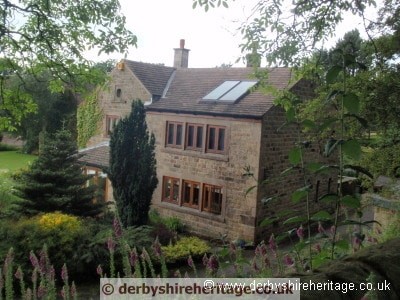
THE BLACK SWAN is over 300 years old and is said to contain the ghost of a “Laughing Cavalier” in its upper rooms.
Bear baiting is said to have taken place in a large hollow above the Black Swan and it would appear that bear baiting took place in Ashover until as recently as 1810. It was recorded by C E Lugard in ‘The Saint and Sinners of Ashover’ that John Smith was sent to prison as a vagabond for being in charge of a bear.
The CRIPTON WELL on Cripton Lane is said to never run dry. It is now overgrown and difficult to find – just listen for running water. It is said that at one time more water was drawn and drunk from this well than from anywhere else in Ashover. It was so popular and with supposed health-giving powers the residents from Ashover’s two hydropathic establishments trekked up to the well to take the waters.
Despite being described as a ‘free school’, pupils paid a weekly fee of 3d. and provided their own slate and books. Homework invariably consisted of twelve or eighteen words to be memorized with spelling and meaning.
A sundial dated 1758 is on the front wall.
ASHOVER PARISH ROOMS were built as a girls’ school in 1877.
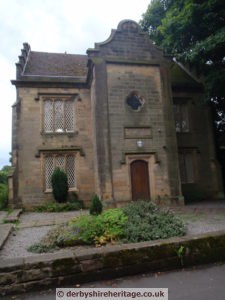
An inscription, “Train up the child in the way he should go and when he is old he will not depart from it”, over the door emphasises the strong moral stance of Victorian educational principles.
With the introduction of free, state education in the late nineteenth and early twentieth centuries, the school at Ashover proved no longer necessary and so the building was converted to Parish Rooms.
At ASHOVER PRIMARY SCHOOL (erected in 1877)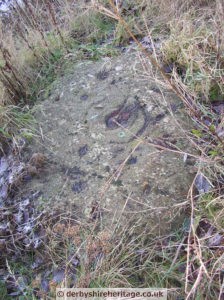 two large gritstone boulders were found by school children whilst carrying out an environmental project. The boulders were identified by archaeologists to be from the neolithic period and prove their was a settlement in Ashover from between 3,000 and 6,000 years ago. One rock is inscribed with cup and ring markings and the other has unidentified writing.
two large gritstone boulders were found by school children whilst carrying out an environmental project. The boulders were identified by archaeologists to be from the neolithic period and prove their was a settlement in Ashover from between 3,000 and 6,000 years ago. One rock is inscribed with cup and ring markings and the other has unidentified writing.
WEST BANK HOUSE was formerly a private school which was run by John Williamson who was Ashover’s parish clerk from 1846 to 1849.
Williamson quarrelled with the rector of the day, Joseph Nodder, who dismissed him for giving out notices in the church on his own account Following this incident Nodder decided to keep the office of parish clerk in his own family.and without authority.
Three WEAVERS’ COTTAGES have been converted to a single dwelling at the junction of Chapel Hill and Hill road. This was at the centre of the stocking frame industry which once rivaled lead mining in importance. The noise from these machines probably accounts for the name Rattle for this area.
As in many other villages (eg Cromford, bonsall etc) the frames were owned and operated by individual families who converted the top floors of their small cottages to install the relatively large machines. Often an enlarged window would also have been installed to allow extra illumination and in many cases it was the man of the house who operated the frame.
In the Eighteenth and Nineteenth Centuries most of the cottages in The Rattle would have housed at least one spinning or weaving frame.
THE WHEATCROFT was home to the author, researcher and publisher Cecil E. Lugard when came to live in Ashover soon after the First World War. Initially he lived for some time at Ambervale and in 1927 he moved to “The Wheatcroft” in Butts Road. Here he set up his own printing press which he called ‘the Dirty Duck’ and printed and bound his own books which were usually limited edition of thirty to fifty copies. In 1923 he published ‘The Inns and Outs of Ashover’ and followed this in 1925 with the larger and more detailed ‘Saints and Sinners of Ashover’.
He used the first floor front room for his writing and was annoyed by any unnecessary interruption to this. To enable him to see who was knocking at his front door he placed a mirror outside the window of this room angled to the street below. This way he was able to decide whether to answer the door and interrupt his work.
THE WHITE LION INN gained the reputation as the most rowdy hostelry in Ashover probably because it was the custom for the local miners to be paid here sat the end of a thirteen week working period, resulting in a weeks drinking, singing and fighting. A skittle alley was situated beside the pub and evidence of stabling also survives in the old pub yard.

